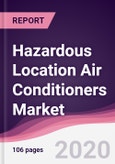What are hazardous location air conditioners?
Hazardous location air conditioning units are designed to operate in the most difficult application by providing safe air conditioning for equipment and personnel. These air conditioners reduce the heat accumulation and maintain a safe operating temperature in hazardous locations. Many features such as a temperature alarm, programmable thermostat and compressor are inbuilt in these air conditioners. These units are easy to install and require less maintenance when compared to traditional hazardous location units. These explosion proof air conditioners can serve all the hazardous divisions, classes and groups.
What are the applications of Hazardous location Air Conditioners?
Hazardous location Air conditioners have wide applications in oil and gas industries, petroleum refining processes, food processing industries, paint & plastic spraying, aircraft hangers, fuel servicing, utility gas plants, grain elevators, flour, feed mills, magnesium & aluminum powder processing, metallurgical processes, plastics, medicines, fireworks, starch, candy, coal and carbon handling processing operations.
Hazardous Location Air Conditioners Market
Market Research and Market Trends of Hazardous location Air conditioners:
Aegex Technologies LLC has developed an IoT platform for hazardous locations specifically for regulated areas in order to prevent explosion. It consists of hardware and software components that capture, transmit, and analyze big data to manage oil and gas refineries, chemical manufacturing plants and other industrial facilities where combustible atmospheres require highly regulated equipment to help improve operations for better safety and productivity.
Pentair’s recently launched an air conditioner specially designed for hazardous location. Hoffman’s SpectraCool Hazardous Location air conditioner has a patented design that eliminates ignition arising from the A/C unit. This engineered design is easy to install and requires low maintenance. The SpectraCool is 20 times lighter when compared to other similar products in the market. It also allows real time monitoring which can help detect the cooling failure and the personnel can be alerted before the damage occurs.
The current trends of hazardous location air conditioning system include increased automation, development of ductless and filter less air conditioning system, improve the energy efficiency and air purification. Several companies have incorporated these trends and thus has a positive impact on the market.
Many companies are designing new purification technology in their air conditioning systems, that would minimize the dust particles and other allergens by purifying the air and keep it smelling fresh and clean. Such systems will have wide scope in food and pharmaceutical industry as it prevents the circulation of impure air and widespread of infections.
Who are the Major Players in Hazardous Location Air Conditioners market?
The companies referred in the market research report are Durable Machinery Company, LLC., EIC Solutions, Inc., Friedrich Air Conditioning co., ltd., Johnson controls, Inc., Klinge Corporation, Kooltronic, Inc., Matticks Industries, Inc., NANCE International, Inc., Safe Air Technology and several others.
What is our report scope?
The report incorporates in-depth assessment of the competitive landscape, product market sizing, product benchmarking, market trends, product developments, financial analysis, strategic analysis and so on to gauge the impact forces and potential opportunities of the market. Apart from this the report also includes a study of major developments in the market such as product launches, agreements, acquisitions, collaborations, mergers and so on to comprehend the prevailing market dynamics at present and its impact during the forecast period 2018-2023.
Key Takeaways from this Report
- Evaluate market potential through analyzing growth rates (CAGR %), Volume (Units) and Value ($M) data given at country level – for product types, end use applications and by different industry verticals.
- Understand the different dynamics influencing the market – key driving factors, challenges and hidden opportunities.
- Get in-depth insights on your competitor performance – market shares, strategies, financial benchmarking, product benchmarking, SWOT and more.
- Analyze the sales and distribution channels across key geographies to improve top-line revenues.
- Understand the industry supply chain with a deep-dive on the value augmentation at each step, in order to optimize value and bring efficiencies in your processes.
- Get a quick outlook on the market entropy – M&A’s, deals, partnerships, product launches of all key players for the past 4 years.
- Evaluate the supply-demand gaps, import-export statistics and regulatory landscape for more than top 20 countries globally for the market.
Table of Contents
Methodology

LOADING...








